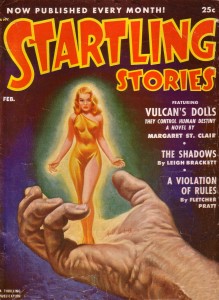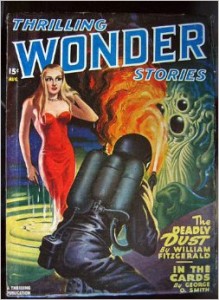 Vulcan’s Dolls
Vulcan’s Dolls
Margaret St. Clair
Startling Stories Feb. 1952, p. 10-73
When I posted my essay “The Women Other Women Don’t See“, I said I would be reading and reviewing the works of some of the women whose contributions to the field have been neglected. “Vulcan’s Dolls” and Margaret St. Clair are a perfect example.
Margaret St. Clair (1911-1995) was active in the field from the late 1940s through the early 1980s, but most of her work was published in the 1950s. Stories that appeared in F&SF carried the byline Idris Seabright. Today, to the extent that she’s known at all, she’s remembered for a handful of short stories.
“Vulcan’s Dolls” was billed as a novel on the cover of the issue of Startling Stories in which it appeared. Stories published as “novels” in the pulps usually weren’t long enough to be considered novels today or long enough to be reprinted in book form. Book length work, as a general rule, was published as serials. Consequently, “Vulcan’s Dolls” has never been reprinted. Startling Stories isn’t a highly sought after pulp, so copies shouldn’t be too hard to come by. I picked mine up at Half Price Books for $3.
Startling Stories, and to a lesser extent its sister publication Thrilling Wonder Stories, mixed fantasy in with the science fiction, sometimes blending the two together. “Vulcan’s Dolls” draws on Greek mythology (St. Clair had an educational background in the classics) but is inarguably science fiction, although the science doesn’t hold up to close scrutiny. Continue reading →
 “Dark Dawn”
“Dark Dawn”


